The StellaMira 90mm ED telescope is a triplet lens apochromatic refractor introduced by First Light Optics.
The packaging of the StellaMira 90mm ED is compact; it is supplied in a neat, lockable, black carry case.
The telescope has a sturdy construction, with a glossy carbon-fibre tube and dew shield.
It certainly looks and feels like a quality piece of equipment, with anodised red aluminium highlights, black tube rings and a carry handle.
Although the carbon-fibre tube keeps the weight down to a mere 3.3kg, the StellaMira 90mm ED doesn’t feel flimsy or compromised in any way whatsoever.
This telescope is among our pick of the best telescopes for astrophotography
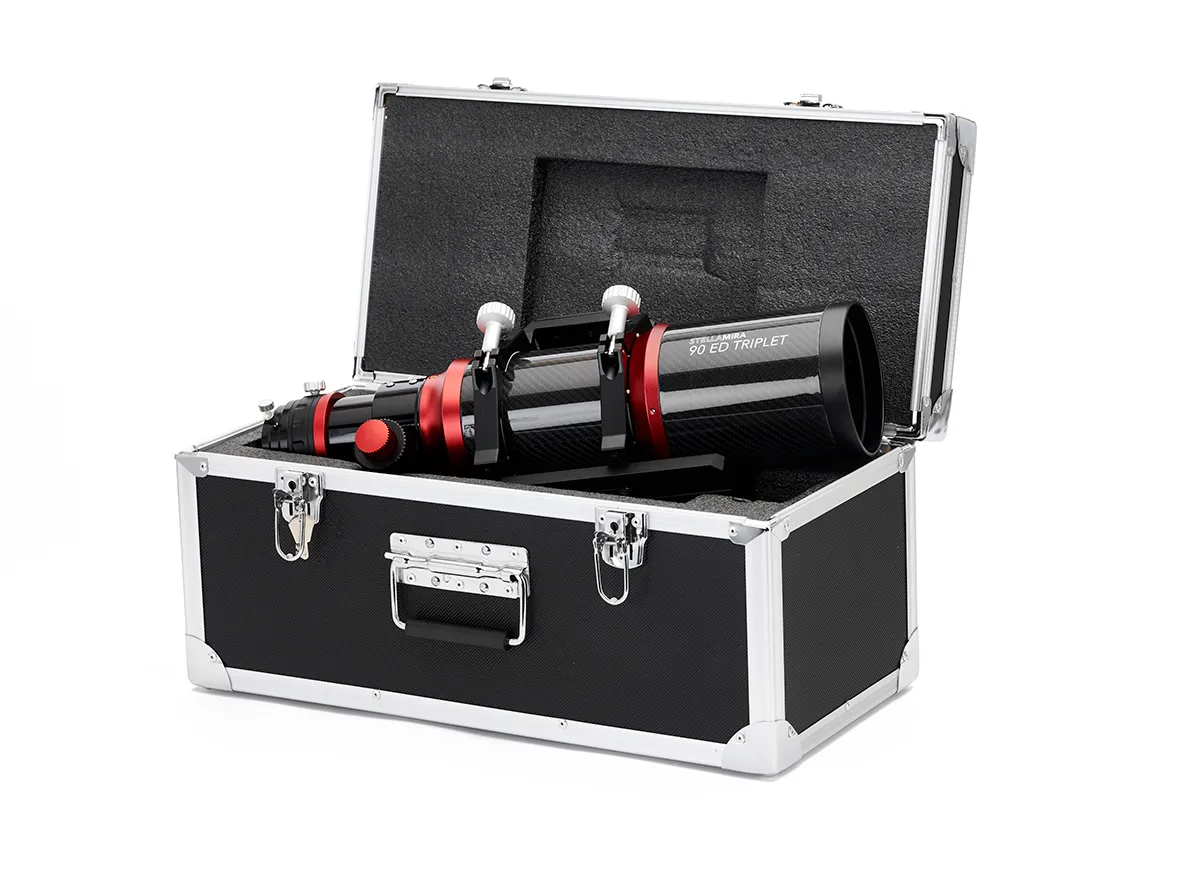
The 90mm lens of the StellaMira telescope has a focal length of 540mm, making it a speedy f/6, and perfectly suited to astrophotography, especially with its focuser design.
There's no reason why it can't also be used as a high-quality, wide-field visual instrument.
Indeed, it’s fitted with a removable holder (for 2-inch and 1.25-inch eyepieces or a diagonal) with brass compression rings.
To test the StellaMira 90mm ED’s astrophotography abilities we paired it with a StellaMira 0.8x reducer/flattener.
This threads firmly onto the focuser, after unscrewing the eyepiece clamp, and the M48 thread on the rear allows a camera to be attached with a spacing of 55mm, which is ideal for DSLR cameras.
With the reducer in place the telescope offers a coma-free image field up to APS-C sensor size.
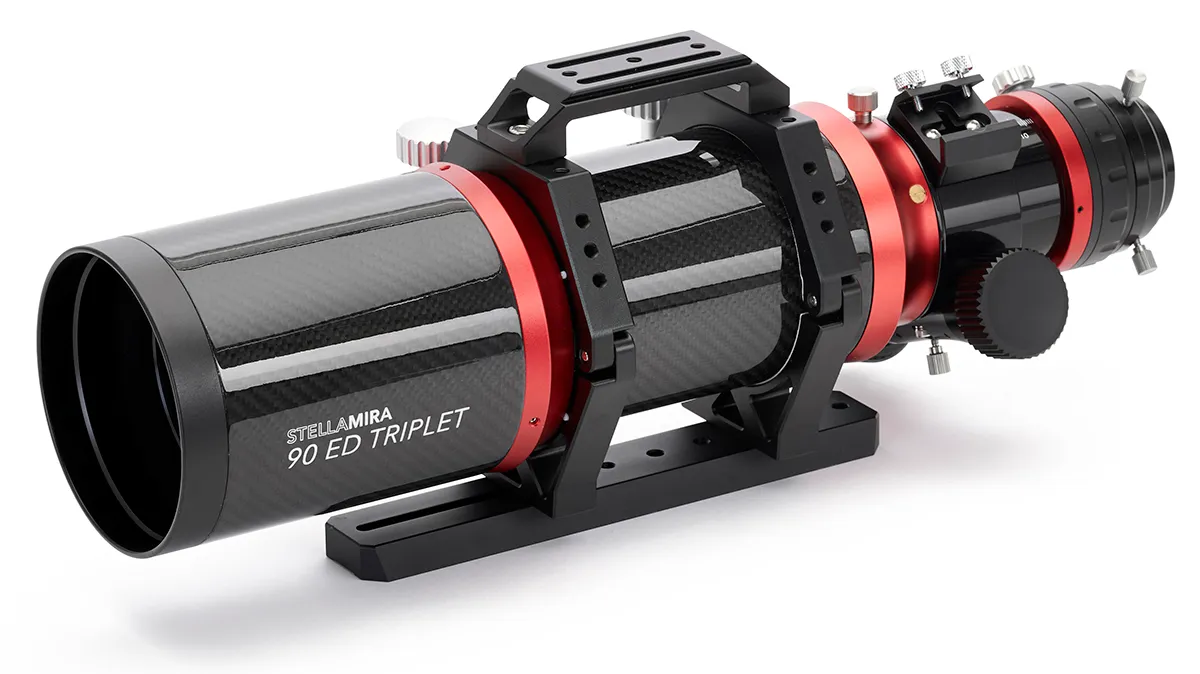
Test pictures were taken using a CCD camera and the back spacing was a few millimetres out, resulting in slightly skewed stars in the corners.
But a selection of reference images (taken with a full-frame DSLR and the correct spacing) showed the true flat field on offer, which covers 36mm x 24mm.
All the stars, except those on the outer edges of the full-frame image, appeared round and sharp.
When it comes to imaging, the focuser arrangement is particularly impressive.
The whole focuser body rotates, allowing the control knobs to be conveniently positioned, while a separate camera rotator allows adjustment of the camera angle.
Fast optical systems have a very shallow depth of focus, requiring precision movements; and in this regard we found the rack and pinion design to be smooth and impressively accurate, especially when making micro-adjustments for perfect focus.
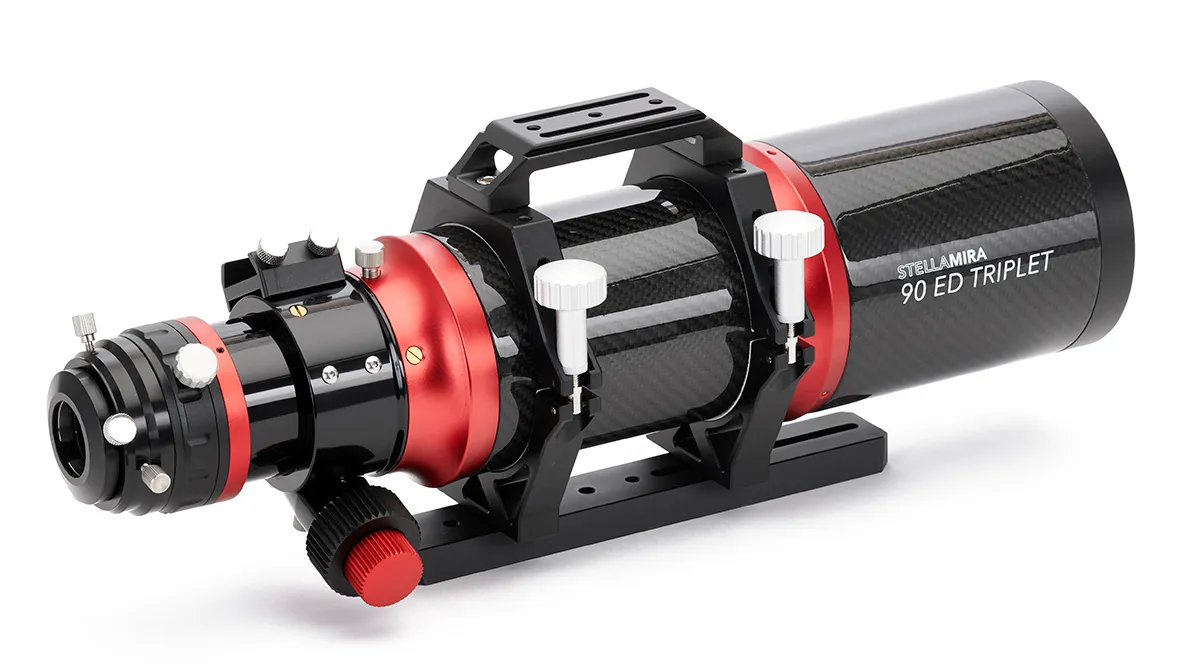
We reviewed this telescope during winter, and as practical astronomers well know, winter skies offer a host of targets.
The Pleiades, M45, and the Orion Nebula, M42, offer pretty much everything an astrophotographer might encounter, including bright dominating stars, faint reflection nebulosity, rich and thin emission nebulae, and tight star groupings that test the telescope’s limits.
The hot blue stars within M45 can produce unwanted artefacts (haloes around stars, irregular diffraction patterns or internal reflections) in poorly configured optics, while the tight star grouping within M42’s Trapezium Cluster can be mangled into an indistinct blob, but our images were clear of these issues.
Instead, the StellaMira 90mm ED produced excellent results, which were consistent with the impressive 0.972 Strehl ratio rating given for this particular telescope (a measure of its optical quality).
There were even tantalising hints of the Trapezium stars ‘E’ (Theta1 (θ1) Orionis E) and ‘F’ (Theta1 (θ1) Orionis F) in M42 during the camera focusing procedure.
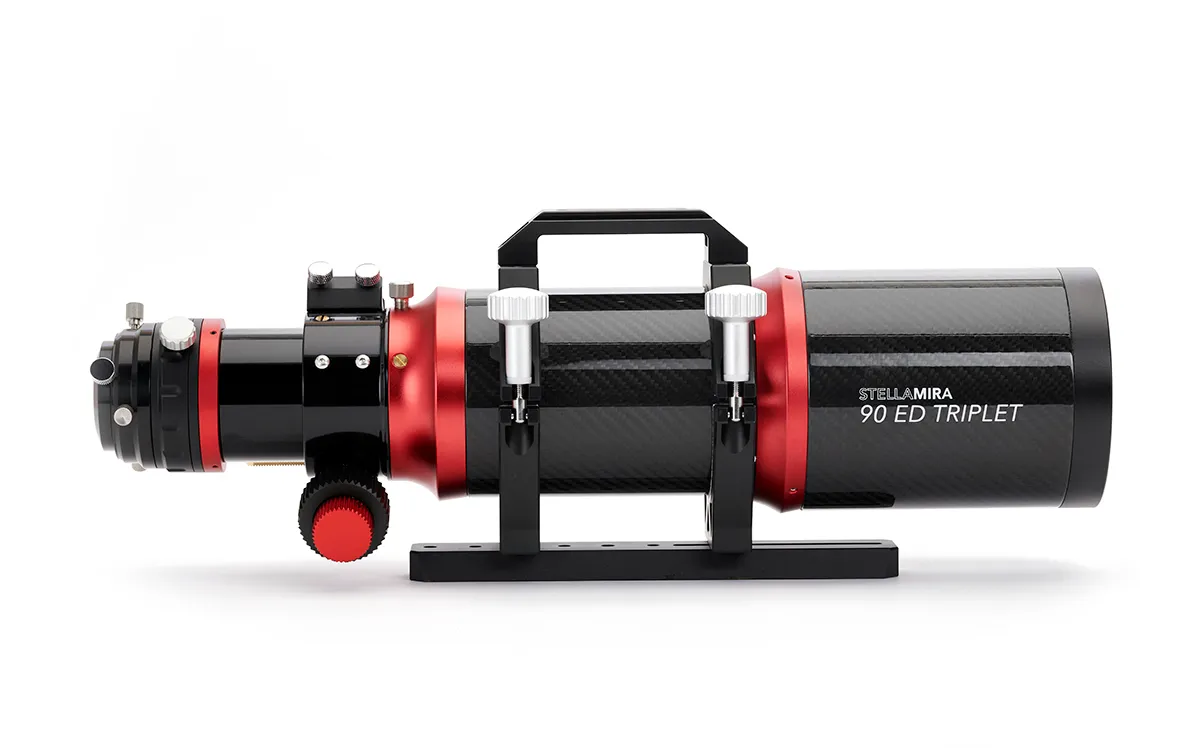
Briefly swapping the camera for an eyepiece was similarly rewarding and delivered excellent views of Jupiter, even using a Barlow lens to boost a 4.5mm eyepiece up to a boundary-stretching 240x magnification.
This produced a sharp, detail-rich image, free of any unwanted colour aberrations, again testifying to the high-quality optics.
Overall, the StellaMira 90mm ED Triplet more than met our expectations.
It’s a competitively priced, stylish telescope that offers excellent views and high-quality astro imaging results in a convenient, well thought out package.
StellaMira 90 telescope's objective lens
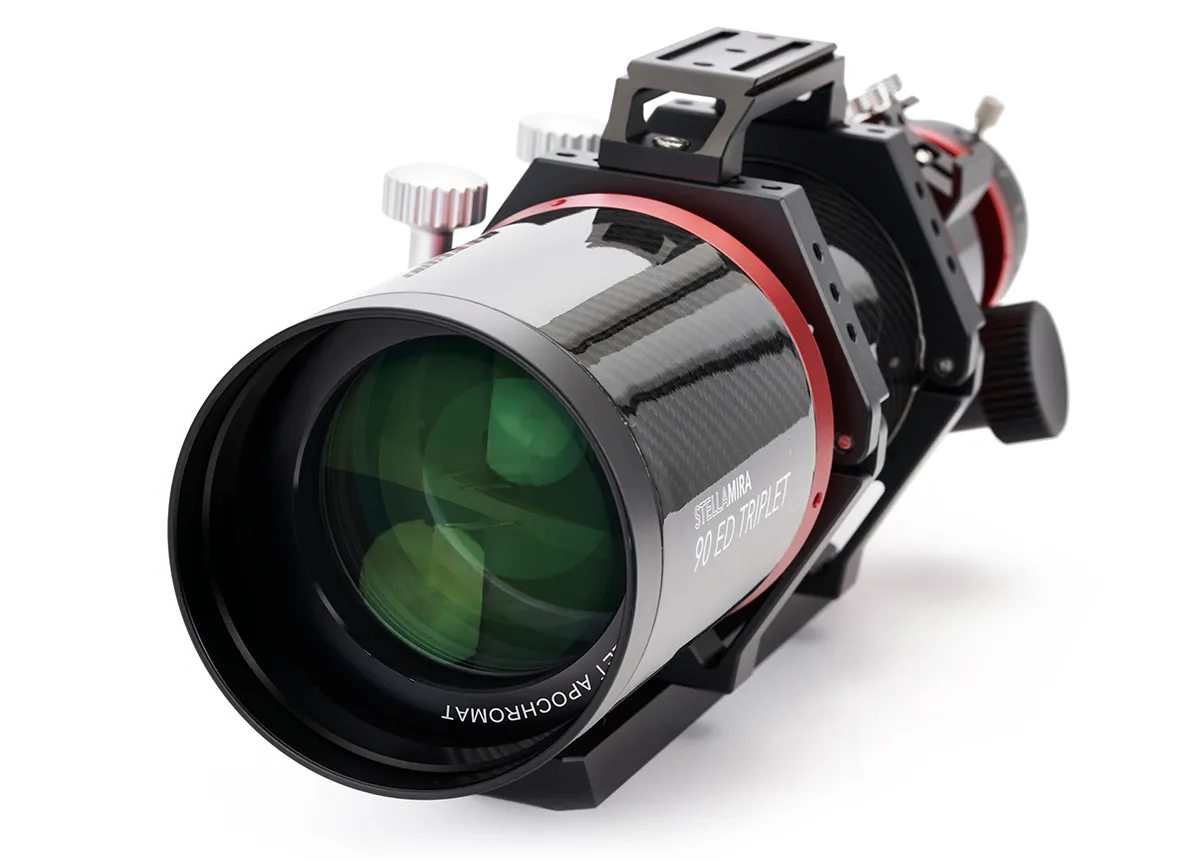
The 90mm objective lens in the StellaMira 90 telescope is made from Extra Low Dispersion (ED) glass, equivalent to FPL-53, and the optics are fully multi-coated for high light transmission and better contrast at the eyepiece/camera.
The triplet lens design allows the telescope to bring the varying colours of light to the same point of focus.
At the eyepiece, this results in sharp planetary or star images, but the good colour correction is more noticeable on bright targets such as the Moon or major planets, as inferior optics produce haloes or rings on the bright edges.
When used for astrophotography, the StellaMira 90mm’s good colour correction is evidenced by sharp, tight star images.
You can test this by photographing the bright, blue stars in the Pleiades and then comparing the pixel sizes of the resulting images, after splitting them into Red, Green and Blue channels.
The different colour star layers we produced overlapped each other almost perfectly, pixel for pixel, demonstrating the true apochromatic fidelity of the StellaMira 90mm ED telescope.
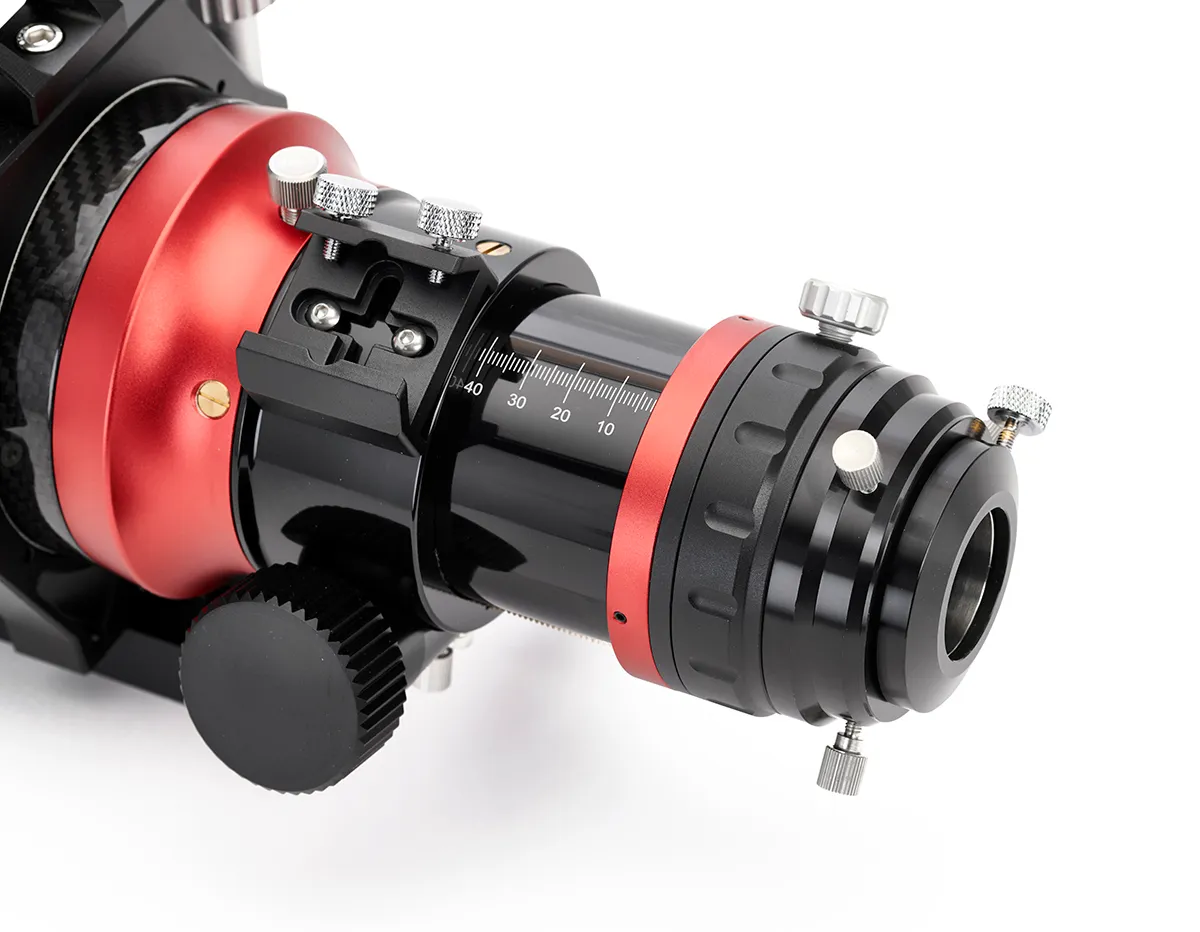
StellaMira 90's 5 best features:
1
Carbon-fibre tube
The lightweight, carbon-fibre tube assembly offers a stylish outward appearance combined with intrinsic strength and rigidity. Carbon-fibre offers greater thermal stability than aluminium during astrophotography sessions, so potentially fewer images are lost to soft focus when outside temperatures change rapidly and expansion or contraction alters the focal point.
2
Focuser
The rotatable focuser is a 2.5-inch rack and pinion design with millimetre graduations on the drawtube. The action is smooth and responsive, and, with 1:10 gearing, is perfect for accurate fine focusing. The integrated camera angle adjuster further allows for separate, easy rotation of the camera through a 360° range.
3
Tube rings and handle
The CNC-machined tube rings and fittings provide a solid, secure setting for the StellaMira 90mm ED. They sit atop a Vixen-style, dovetail bar and incorporate a combined carry handle and accessory rail. An additional Synta-style finderscope shoe is mounted to the rotatable body of the focuser.
4
Optical report and quality control
Each StellaMira 90mm ED telescope comes with its own optical report from the factory and a guaranteed minimum Strehl ratio of 0.95 (an indicator of its optical quality). In addition, prior to shipping to customers, each telescope is checked on the supplier’s in-house optical bench, and the focuser and fittings are quality checked too.
5
Carry case
The StellaMira 90mm ED is lightweight, compact and highly portable. It can be transported safely in the dedicated aluminium case, which has foam cut-outs that hold the telescope snugly. The whole package (case included) weighs just over 4kg, making it great for use as a high-quality travel telescope.
Vital stats
- Price: £1,449
- Optics: f/6 apochromatic triplet
- Aperture: 90mm
- Focal length: 540mm
- Focuser: 2.5-inch rack and pinion
- Extras: Tube rings and a carry case
- OTA weight: 3.3kg
- Supplier: First Light Optics
- www.firstlightoptics.com
This review originally appeared in the March 2022 issue of BBC Sky at Night Magazine.
